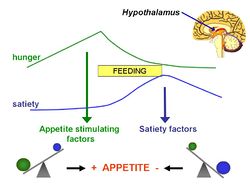Aminostatic hypothesis: Difference between revisions
imported>Ashleigh Fraser No edit summary |
imported>Lisa Robertson |
||
| Line 37: | Line 37: | ||
==References== | ==References== | ||
{{reflist | 2}} | {{reflist | 2}} | ||
(A)Centers for Disease Control and Prevention. (2011). U.S Obesity Trends. Available: http://www.cdc.gov/obesity/data/trends.html. Last accessed 25th Oct 2011. | |||
(B)Department of Health. (2011). Obesity. Available: http://www.dh.gov.uk/en/Publichealth/Obesity/index.htm. Last accessed 25th Oct 2011. | |||
Revision as of 09:35, 25 October 2011
For the course duration, the article is closed to outside editing. Of course you can always leave comments on the discussion page. The anticipated date of course completion is 01 April 2012. One month after that date at the latest, this notice shall be removed. Besides, many other Citizendium articles welcome your collaboration! |
In 1956, Mellinkoff proposed the aminostatic hypothesis, stimulated by the observation that when normal individuals ingest protein, appetite diminishes as the serum amino acid concentration rises and vice versa.[1] He believed this was due to a satiety centre in the brain, sensitive to serum amino acids levels, that caused a suppression of hunger once the serum levels reached a certain point.Ashleigh Fraser 15:34, 25 October 2011 (UTC)
Experimental Evidence
-experimental evidence has agreed with the aminostatic hypothesisAshleigh Fraser 15:34, 25 October 2011 (UTC)
-they have found that high protein diets act on satiety and thermogenesisAshleigh Fraser 15:34, 25 October 2011 (UTC)
Science behind the theory
Use as a method of weight loss
Obesity is everywhere. Around 33% of American adults and 17% of children are obese. In the UK, the statistics are not looking much brighter with 25% of adults and 10% of children showing signs of obesity. It has been proposed in the UK that 60% of men, 50% of women and 25% of children will become obese by 2050 if no preventative measures are taken. This growing prevalence of obesity needs a solution. Many hypotheses regarding different weight loss diets have been proposed. So how can the aminostatic hypothesis be used for treatment? Perhaps a high protein diet is the answer.
- What does the diet consist of? Benefits of high protein diet with supporting evidence (2,3,7,8,10). Animal/veg protein best?
Limitations
-are there any downsides to a high protein diet?
-appetite is a feeling so different participants in experiments may report it differently and so results may not be completely accurateAshleigh Fraser 15:34, 25 October 2011 (UTC)
- Consequent effects on renal function. Usually low carb diet is needed along with HP diet to gain full beneficial effects (subjects more satisfied).
References
- ↑ Mellinkoff SM et al. (1956) Relationship between serum amino acid concentration and fluctuations in appetite J Appl Physiol 8:535-8 PMID 13295170
(A)Centers for Disease Control and Prevention. (2011). U.S Obesity Trends. Available: http://www.cdc.gov/obesity/data/trends.html. Last accessed 25th Oct 2011.
(B)Department of Health. (2011). Obesity. Available: http://www.dh.gov.uk/en/Publichealth/Obesity/index.htm. Last accessed 25th Oct 2011.
